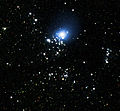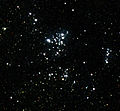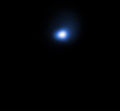M33 X-7: Difference between revisions
Citation bot (talk | contribs) Alter: date, title. Add: bibcode, doi, page, issue, volume, journal. | Use this bot. Report bugs. | Suggested by Abductive | Category:Stellar black holes | #UCB_Category 3/37 |
→Observational data: A heavier star cannot orbit a lighter one in terms of mass. Corrected this error and added three 2010 papers as sources, incorrectly cited by the pointed out source at the end of the paragraph. |
||
| Line 64: | Line 64: | ||
File:M33x7 xray bright.jpg|M33 X-7 |
File:M33x7 xray bright.jpg|M33 X-7 |
||
</gallery> |
</gallery> |
||
In new models of the formation of the black hole, the star that will form the black hole is nearly 100 times the mass of the Sun, orbited by a second star with mass of about {{Solar mass|30}}.<ref>{{cite news|url=https://ui.adsabs.harvard.edu/abs/2010ASPC..425..227V/abstract|title=The Eclipsing Black Hole X-ray Binary M33 X-7: Understanding the Current Properties|work=[[NASA ADS]]|accessdate=October 7, 2024|date=June 1, 2010}}</ref><ref>{{cite news|url=https://ui.adsabs.harvard.edu/abs/2010Natur.468...77V/abstract|title=Formation of the black-hole binary M33 X-7 through mass exchange in a tight massive system|work=[[NASA ADS]]|accessdate=October 7, 2024|date=November 4, 2010}}</ref><ref>{{cite news|url=https://ui.adsabs.harvard.edu/abs/2010AIPC.1314..285V/abstract|title=The Intriguing Evolutionary History of the Massive Black Hole X-ray Binary M33 X-7|work=[[NASA ADS]]|accessdate=October 7, 2024|date=December 22, 2010}}</ref> |
|||
In new models of the formation of the black hole, the star that will form the black hole is nearly 100 times the mass of the Sun, orbiting a second star with mass of about {{Solar mass|30}}. |
|||
In such an orbit, the future black hole is able to start transferring mass while it is still fusing [[hydrogen]] into [[helium]]. As a result, it loses most of its hydrogen becoming a [[Wolf–Rayet star]] and shedding the rest of the envelope in the form of stellar wind, exposing its core. Its companion grows more massive in the process, becoming more massive of the two stars. |
In such an orbit, the future black hole is able to start transferring mass while it is still fusing [[hydrogen]] into [[helium]]. As a result, it loses most of its hydrogen becoming a [[Wolf–Rayet star]] and shedding the rest of the envelope in the form of stellar wind, exposing its core. Its companion grows more massive in the process, becoming more massive of the two stars. |
||
Latest revision as of 23:36, 6 October 2024
| Observation data Epoch J2000.0 Equinox J2000.0 | |
|---|---|
| Constellation | Triangulum |
| Right ascension | 01h 33m 34.13s[1] |
| Declination | +30° 32′ 11.3″[1] |
| Apparent magnitude (V) | +18.70[1] |
| Characteristics | |
| Spectral type | O7-8III / Black hole[2] |
| Astrometry | |
| Distance | 2700000±70000 ly (840000±20000[2] pc) |
| Orbit[2] | |
| Period (P) | 3.45301 ± 0.00002 d |
| Semi-major axis (a) | 42.4 ± 1.5 R☉ |
| Eccentricity (e) | 0.0185 ± 0.0077 |
| Inclination (i) | 74.6 ± 1.0° |
| Details[2] | |
| O-type star | |
| Mass | 70 ± 6.9 M☉ |
| Temperature | 35000 ± 1000 K |
| Black hole | |
| Mass | 15.65 ± 1.45 M☉ |
| Radius | 0.000066 ± 0.0000061 R☉ |
| Other designations | |
2E 408, 2E 0130.7+3016, RX J0133.5+3032, CXOU J013334.1+303210 | |
| Database references | |
| SIMBAD | data |
M33 X-7 is a black hole binary system in the Triangulum Galaxy. The system is made up of a stellar-mass black hole and a companion star. The black hole in M33 X-7 has an estimated mass of 15.65 times that of the Sun (M☉)[3][4] (formerly the largest known stellar black hole, though this has now been superseded amongst electromagnetically-observed black holes by an increased mass estimate for Cygnus X-1,[5] and also by many of the LVK-detected binary black hole components[6]). The total mass of the system is estimated to be around 85.7 M☉, which would make it the most massive black hole binary system. The black hole is consuming its partner, a 70 solar mass blue giant star.
Location
[edit]M33 X-7 lies within the Triangulum Galaxy which is approximately 3 million light-years (ly) distant from the Milky Way in constellation Triangulum. This would make M33 X-7 one of the furthest confirmed stellar mass black holes known.[7]
System
[edit]M33 X-7 orbits a companion star that eclipses the black hole every 3.45 days. The companion star also has an unusually large mass, 70 M☉. This makes it the most massive companion star in a binary system containing a black hole.[7]
Observational data
[edit]The black hole was studied in combination by NASA's Chandra X-ray Observatory and the Gemini telescope on Mauna Kea, Hawaii.
The properties of the M33 X-7 binary system are difficult to explain using conventional models for the evolution of massive stars. The parent star for the black hole must have had a mass greater than the existing companion to have formed a black hole before the companion star. Such a massive star would have had a radius larger than the present separation between the stars, so the stars must have been brought closer while sharing a common outer atmosphere. This process typically results in a large amount of mass being lost from the system, so much that the parent star should not have been able to form a 15.7 M☉ black hole.
-
M33 X-7 composite
-
M33 X-7 Optical
-
M33 X-7 X-ray
-
M33 X-7
In new models of the formation of the black hole, the star that will form the black hole is nearly 100 times the mass of the Sun, orbited by a second star with mass of about 30 M☉.[8][9][10]
In such an orbit, the future black hole is able to start transferring mass while it is still fusing hydrogen into helium. As a result, it loses most of its hydrogen becoming a Wolf–Rayet star and shedding the rest of the envelope in the form of stellar wind, exposing its core. Its companion grows more massive in the process, becoming more massive of the two stars.
Finally, the star collapses creating the black hole, and begins absorbing material from its companion, leading to X-ray emissions.[11]
Future
[edit]Due to the mass, it is assumed that the companion will collapse into a black hole, creating a binary black hole system.[12]
See also
[edit]References
[edit]- ^ a b c "M33 X-7". SIMBAD. Centre de données astronomiques de Strasbourg. Retrieved 4 December 2016.
- ^ a b c d Valsecchi, Francesca; Glebbeek, Evert; Farr, Will M.; Fragos, Tassos; Willems, Bart; Orosz, Jerome A.; Liu, Jifeng; Kalogera, Vassiliki; Kologera, Vicky; Van Der Sluys, Marc (2010). The Intriguing Evolutionary History of the Massive Black Hole X-ray Binary M33 X-7 (PDF). International Conference on Binaries: In Celebration of Ron Webbink's 65Th Birthday. AIP Conference Proceedings. Vol. 1314. pp. 285–290. arXiv:1010.4742. Bibcode:2010AIPC.1314..285V. doi:10.1063/1.3536386. S2CID 119301068.
- ^ "NASA - Heaviest Stellar Black Hole Discovered in Nearby Galaxy".
- ^ Valsecchi, Francesca; Glebbeek, Evert; Farr, Will M.; Fragos, Tassos; Willems, Bart; Orosz, Jerome A.; Liu, Jifeng; Kalogera, Vassiliki (2010). "Formation of the black-hole binary M33 X-7 through mass exchange in a tight massive system". Nature. 468 (7320): 77–79. arXiv:1010.4809. Bibcode:2010Natur.468...77V. doi:10.1038/nature09463. PMID 20962778. S2CID 4353636.
- ^ Miller-Jones, James C. A.; Bahramian, Arash; Orosz, Jerome A.; Mandel, Ilya; Gou, Lijun; Maccarone, Thomas J.; Neijssel, Coenraad J.; Zhao, Xueshan; Ziółkowski, Janusz; Reid, Mark J.; Uttley, Phil (2021-03-01). "Cygnus X-1 contains a 21-solar mass black hole—Implications for massive star winds". Science. 371 (6533): 1046–1049. arXiv:2102.09091. Bibcode:2021Sci...371.1046M. doi:10.1126/science.abb3363. ISSN 0036-8075. PMID 33602863. S2CID 231951746.
- ^ The LIGO Scientific Collaboration; the Virgo Collaboration; the KAGRA Collaboration; Abbott, R.; Abbott, T. D.; Acernese, F.; Ackley, K.; Adams, C.; Adhikari, N.; Adhikari, R. X.; Adya, V. B. (2023). "GWTC-3: Compact Binary Coalescences Observed by LIGO and Virgo during the Second Part of the Third Observing Run". Physical Review X. 13 (4): 041039. arXiv:2111.03606. Bibcode:2023PhRvX..13d1039A. doi:10.1103/PhysRevX.13.041039.
- ^ a b "Heaviest Stellar mass Black Hole Discovered in Nearby Galaxy". Chandra.Harvard.edu. October 17, 2007. Retrieved September 28, 2012.
- ^ "The Eclipsing Black Hole X-ray Binary M33 X-7: Understanding the Current Properties". NASA ADS. June 1, 2010. Retrieved October 7, 2024.
- ^ "Formation of the black-hole binary M33 X-7 through mass exchange in a tight massive system". NASA ADS. November 4, 2010. Retrieved October 7, 2024.
- ^ "The Intriguing Evolutionary History of the Massive Black Hole X-ray Binary M33 X-7". NASA ADS. December 22, 2010. Retrieved October 7, 2024.
- ^ "Massive Black Hole Binary Explained". Space.com. January 24, 2011. Retrieved October 10, 2010.
- ^ "M33 X-7 Fact Sheet". Stardate.org. January 24, 2011. Archived from the original on November 2, 2010. Retrieved September 28, 2012.





